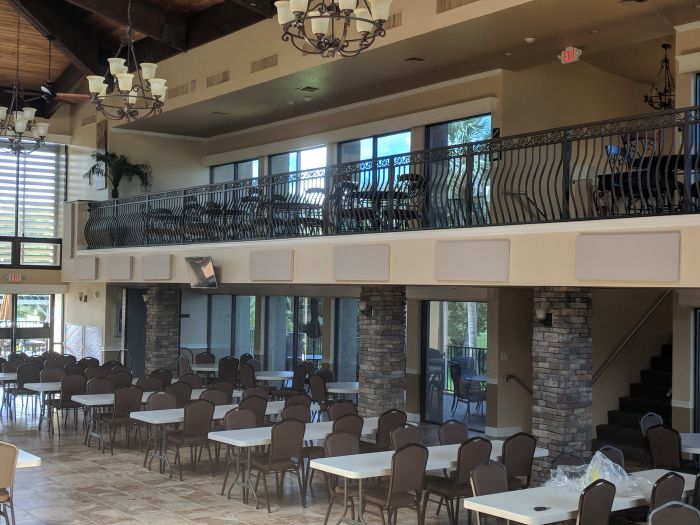As is often the case, large clubhouses with reflective surfaces are particularly vulnerable to excessive reverberation. This is usually not noticed until after construction, leaving property managers to determine how to treat the issue. It’s often brought to management’s attention when the users of the clubhouse determine that it’s not acceptably treated to perform various activities in the clubhouse; such as mixers and networking events, bingo, and other social activities.
Luckily, acoustic treatment for reverb is much more easily accomplished after construction than other soundproofing efforts.
How to Acoustically Treat a Clubhouse for Echo
Step 1: Determine amount of Acoustic Treatment needed in the Clubhouse
This may be done in one of two ways. The first is to perform a field measurement. This is done by creating an impulse noise such as popping a balloon or using a calibrated impulse noise generator. The resulting echo is then measured with a calibrated meter. In this case the clubhouse (based in Ocala, FL) had excessive reverberation in the range of 3.5 seconds on a dBA scale. This is much longer than the suggested amount in a multi-purpose room, from 1.5 to 2 seconds.
Another way to determine the amount of acoustic treatment needed is to model the room. You can use an acoustic calculator and plug in the size of each of the walls, along with the surface finishes. This will allow an acoustic calculator to perform a Sabins calculation, resulting in the amount of reverberation that is expected in that space.
NOTE: while modeling is a great tool for small to medium-sized rooms, it can often overestimate how much absorption is needed in larger rooms or in rooms with unique geometries.
Step 2: Determine Acoustical Product Type – Absorption Panels, Clouds, Baffles, or Other
There are a number of acoustical products on the market. These range from standard acoustic panels, to custom acoustic panels, art-wrapped acoustic panels, or Acoustical Fabric Wall systems. There are also acoustic ceiling clouds and baffles, along with an assortment of other more unique (and typically more expensive) acoustic treatment options.
Now that you know, from Step 1, the amount of treatment needed, you can get a quote on the number of acoustic panels or fabric wall system needed to achieve that rating. In the earlier case of the Ocala clubhouse, it was calculated that approximately 90 acoustic panels would be needed to treat the echo issue.
NOTE: 2″ thick panels are generally recommended. This is because they have a higher NRC, or noise reduction coefficient. But even more importantly, they have high absorption ratings at lower frequencies. This is critical if amplified speech or music is to be used in the clubhouse space.
Step 3: install the Acoustic Treatment in the Clubhouse Space and Test
Once the acoustic fabrics are selected and the panels are fabricated, the installation team can install them in the clubhouse. They can be installed along the ceiling the walls or suspended from other services.
The 90 acoustic panels in this clubhouse were wall-mounted, using impaling clips to quickly and easily secure them to the wall. They are installed above eye height to minimize touching of the panels, which would generally lead to staining and or denting over time. For more active spaces, we generally recommend using an impact resistance panel, although all panels are resin hardened.
A quick reverberation test after installation of the acoustic panels can help determine the final rating of the clubhouse. This is critical to the to determine if any additional acoustic treatment may be needed. In this case, the reverberation drop to below 1.8 seconds, which ensured that the clubhouse was adequately treated to host a wide range of activities.
Acoustic Treatments for Clubhouses – Sound Systems, Music, or Events
Summary: Clubhouses often have echo problems. These may be solved with a variety of acoustic absorption options. First test the space or model it to determine how much treatment the clubhouse needs. Then determine the appropriate acoustic product that’s within your price range and fits your installation schedule. Finally install the acoustic treatment and post-test to ensure that adequate treatment was used and that an ideal reverberation time was realized. By following this systematic approach, you can ensure that your clubhouse will no longer have echo or reverberation issues.
See Additional Clubhouse Echo Treatment Options Here



